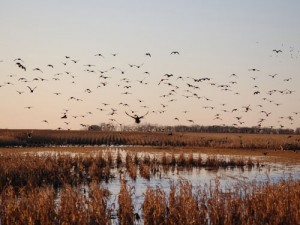
Member Photo Credit: Canman OMaddie
As Minnesota waterfowl experts begin planning for the 2013 hunting season they are pleased with a memorable 2012.
An earlier season opener, regulation changes that created more opportunity and some timely help from Mother Nature all combined to make 2012 a noteworthy season.
“We expected it to be a good season and, by all accounts, it was,” said Steve Cordts, waterfowl specialist for the Minnesota Department of Natural Resources (DNR). “We’ve heard a lot of positive reports from hunters. Most seemed very satisfied.”
The DNR added a third duck zone in southern Minnesota and used different splits, or closed periods, to provide some later hunting in that part of the state.
“The season structure we used this year allowed for almost a second opener effect in our south duck zone as well as some late season hunting, which both seemed to work well based on the reports we heard,” Cordts said.
This year, Cordts said, the agency is considering even more changes, including allowing Canada geese hunting in August, changing the early goose season bag limit and allowing open water duck hunting on a small number of lakes.
“No decisions have been made – and some would require federal approval – but we are floating these concepts out for discussion and feedback,” said Cordts. He said formal public input will be taken later this year.
Although 2012 duck harvest numbers will not be available until summer, an increase in harvest is expected. Duck harvest in recent years has been around 650,000 ducks. Mallards typically rank first followed by wood ducks, blue-winged teal, ring-necked ducks and green-winged teal.
“By most accounts, ring-necked duck numbers and hunting success were lower this fall than recent years but that was about the only negative during the entire season,” Cordts said.
Almost half of the state’s annual duck harvest occurs during the first two weekends of the season. The early opening date provided good hunting across the state for blue-winged teal and wood ducks. Reports of good mallard hunting came throughout the season, and timely weather systems in late October and early November provided some excellent waterfowl hunting days.
Waterfowl habitat conditions were extremely dry statewide the entire season, which made access more difficult in many areas but also made for hunting success.
“In some of the drier regions, if you could find water, it held ducks,” Cordts said. “In other regions, the dry conditions improved waterfowl foraging opportunities, especially for dabbling ducks.”
An early crop harvest provided numerous field hunting opportunities for Canada geese, and the lack of snow into December resulted in good numbers of geese scattered across the state throughout fall.
“We didn’t see the large concentrations of migrant Canada geese at some of the traditional staging areas like Lac qui Parle Wildlife Management Area but still had good Canada goose hunting across the state,” Cordts said.
Cordts noted that even though the 2012 duck season ended on a positive note the major prairie breeding regions of Minnesota and the Dakotas are exceptionally dry. Moreover, high commodity prices and rising global demand for food and energy are having a significant negative impact on wildlife habitat because more land is going into farm production.
“Nearly 3 million acres of Conservation Reserve Program ground in Minnesota and the Dakotas have been converted from wildlife habitat to mainly row crops since 2008,” said Cordts. “To put that in perspective, that’s nearly 5,000 square miles, which translates into a 20-mile wide corridor along Interstate 94 from St. Paul to Fargo, N.D.
“Taken together, dry conditions and habitat loss will have significant negative consequences for ducks in future years.”
Final waterfowl stamp sales in 2012 were 89,950. Stamp sales have held stable the past four years at just under 90,000.
“We’d like to see our hunter numbers increase but at least they’ve stabilized,” said Cordts. “We will continue to explore opportunities for additional hunter recruitment and retention.”





